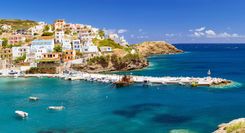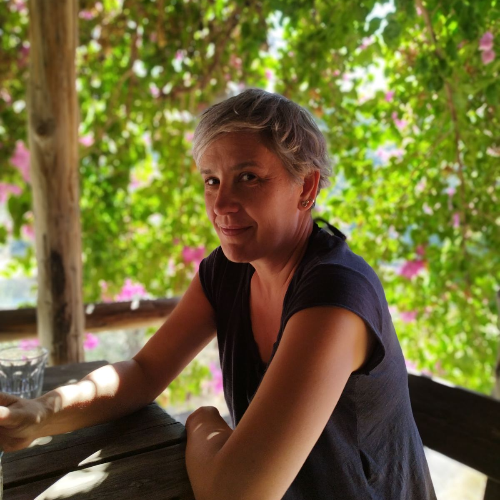If you are male, over 18 years old and have a genuine interest in monasticism or Greek Orthodoxy, sacred music or simply in Byzantine and medieval architecture, a visit is strongly recommended; this requires a permit which can be easily arranged in Thessaloníki. In addition to the religious and architectural aspects of Athos, it should be added that the peninsula remains one of the most beautiful parts of Greece. For many visitors, this – as much as the experience of monasticism – is the highlight of time spent on the Holy Mountain.
Brief history
The development of monasticism on Athos is a matter of some controversy, and foundation legends abound. The most popular asserts that the Virgin Mary was blown ashore here on her way to Cyprus. The earliest historical reference to Athonite monks is to their attendance at a council of the Empress Theodora in 843; probably there were some monks here by the end of the seventh century. In 885 an edict of Emperor Basil I recognized Athos as the sole preserve of monks, and gradually hermits came together to form communities known in church Greek as koinobia (literally “common life”). The year 963 is the traditional date for the foundation of the first monastery, Meyístis Lávras, by Athanasios the Athonite, largely financed by Emperor Nikiforos Fokas. Over the next two centuries foundations were frequent, the monasteries reaching forty in number, alongside many smaller communities.
Troubles for Athos began at the end of the eleventh century. The monasteries suffered sporadically from pirate raids and from the settlement of three hundred Vlach shepherd families on the mountain. After a reputedly scandalous episode between the monks and the shepherdesses, the Vlachs were ejected and a new imperial edict was issued, confirming that no female mammal, human or animal, be allowed to set foot on Athos. This edict, called the ávaton, remains in force today, excepting cats to control rodents.
During the twelfth century, the monasteries gained an international – or at least, a pan-Orthodox – aspect, as Romanian, Russian and Serbian monks flocked to the mountain in retreat from the turbulence of the age, although the peninsula itself was subject to raids by Franks and Catalans over the next two centuries. After the fall of the Byzantine Empire to the Ottomans, the fathers wisely declined to resist, maintaining good relations with the early sultans, one of whom paid a state visit.
The mountain’s real decline came after the early nineteenth-century War of Independence, in which many of the monks fought alongside the Greek revolutionary forces but paid the price when Macedonia was easily subdued. This led to a permanent Turkish garrison and the first drastic reduction in the monastic population, which did not increase even when Macedonia returned to Greece in 1912. The Athonite fathers, however, resisted diluting the Greek nature of the Holy Mountain with too many foreign (mainly Russian) monks. By the early 1960s numbers were at their lowest, barely a thousand, compared to 20,000 in Athos’s heyday. Today, however, the monastic population has climbed to about two thousand, its average age has dropped significantly and the number of well-educated monks has increased markedly. While Athos remains a part of Greece, all foreign monks must adopt Greek citizenship and the Greek civil government is represented by an appointed governor and a small police force.
The monasteries
Obviously you can’t hope to visit all twenty monasteries during a short stay, though if you’re able to extend the basic four-day permit period you can see the most prominent foundations. Each monastery has a distinct place in the Athonite hierarchy: Meyístis Lávras holds the prestigious first place, Konstamonítou ranks twentieth. All other settlements are attached to one or other of the twenty “ruling” monasteries; the dependencies range from a skíti, or minor monastic community (either a group of houses, or a cloister-like compound scarcely distinguishable from a monastery), through a kellí (a sort of farmhouse) to an isyhastírio (a solitary hermitage, often a cave). Numerous laymen – including many Muslim Albanians of late – also live on Athos, mostly employed as agricultural or manual labourers by the monasteries.
For simplicity’s sake it is easiest to divide the monasteries according to which coast of the peninsula they belong to, southwestern or northeastern; our listings (see Monastery accommodation), which give brief descriptions of the main highlights, reflect this division. The institutions of each coast are described in geographical order, starting with those closest to the mainland. Apart from the four skítes that accept overnight visitors and thus merit their own entry, all other dependencies are mentioned in the account of their ruling monastery.
Mount Athos time
The traditional Byzantine daily schedule observed on Athos is somewhat disorienting. On the northeast side of the peninsula the “12 o’clock” position on monastery clocks indicates neither noon nor midnight but sunrise, whereas on the opposite side of Athos it coincides with sunset. Yet Vatopedhíou, the largest monastery, keeps “worldly” time, as do most monks’ wristwatches, and in many monasteries two wall clocks are mounted side by side, one showing secular, the other “Byzantine” time. However, the Julian calendar, a fortnight behind the outside world, is observed throughout Athos. Bedtime is shortly after sunset and in the small hours your hosts will awake for solitary meditation and study, followed by órthros, or matins. Around sunrise there is another quiet period, just before the akolouthía, or main liturgy, that precedes the morning meal. The rest of the day is devoted to manual labour until the esperinós, or vespers, followed immediately by the afternoon meal and the short apódhipno, or compline service.
Athos etiquette
It’s worth remembering that the monks on Athos are expecting religious pilgrims, not tourists. Each monastery varies a good deal in their handling of visitors; signs at some institutions specifically forbid you from attending services or sharing meals with the monks. Others put themselves at the disposal of visitors of whatever creed (though you may well find yourself being encouraged to switch to Greek Orthodoxy!). Yet, wherever you stay there’s a certain amount of etiquette to observe.
You must reach the monastery where you will overnight before dark, since they all lock their front gates at sunset – which would leave you outside with the wild boars. Upon arrival you should ask for the guestmaster (arhondáris), who will proffer the traditional welcome of a tsípouro, loukoúmi (Turkish delight) and often a Greek coffee, before showing you to your bed. Most guestmasters speak good English.
You should be fully dressed at all times, even when going from dormitory to bathroom; shorts should not be worn anywhere on the peninsula, nor hats inside monasteries. Swimming is officially prohibited, so if you are tempted, choose a cove where nobody can see you, and certainly don’t skinny-dip. Smoking is forbidden, though it is often tolerated outside the monastery walls; it would be criminal to smoke on the trail, however, given the chronic fire danger. Singing, whistling and raised voices are taboo; as is standing with your hands behind your back or in your pockets. If you want to photograph monks you should always ask permission, though photography is forbidden altogether in many monasteries, and video cameras are completely banned from the Mountain.






